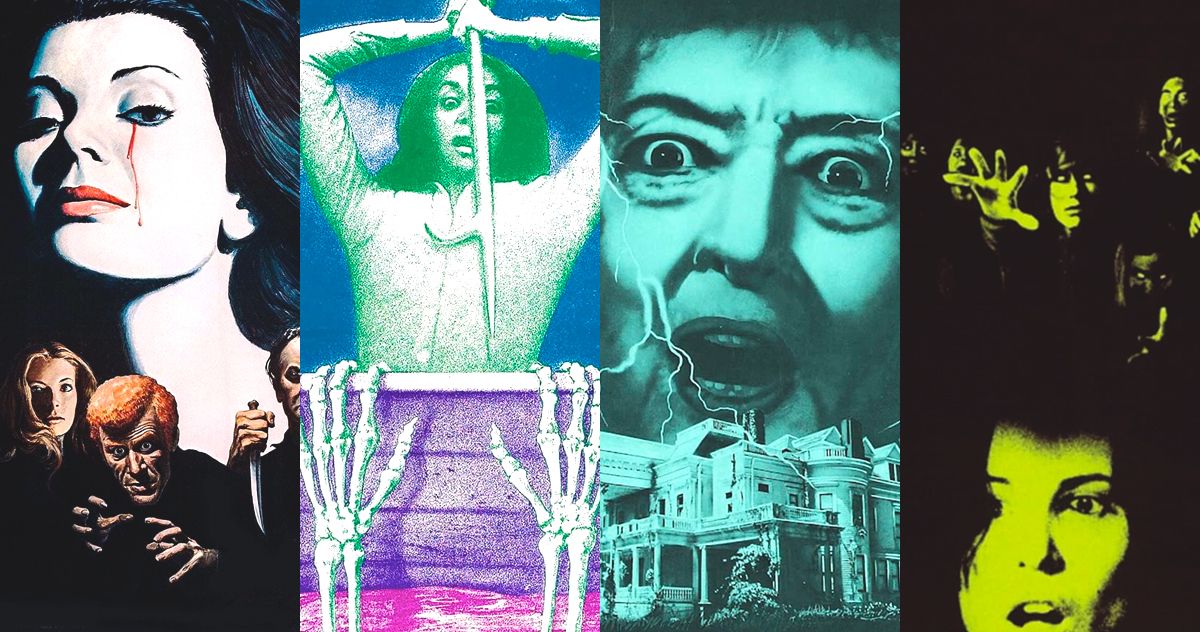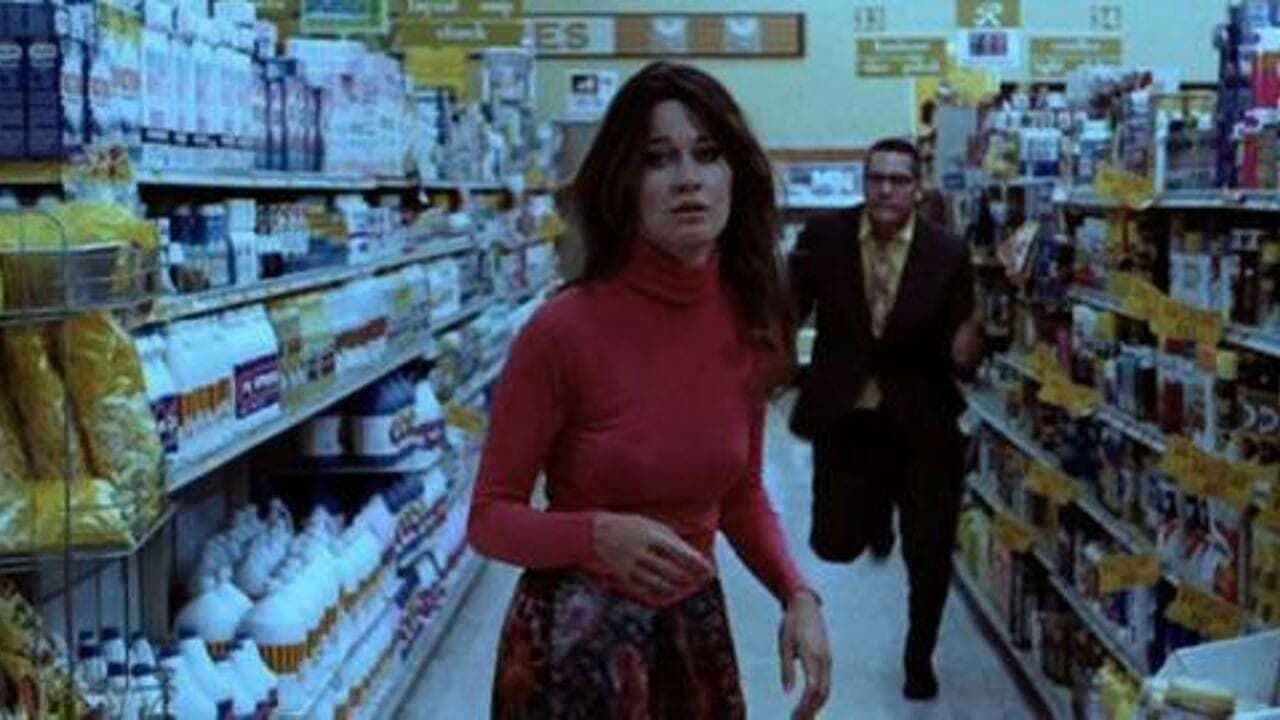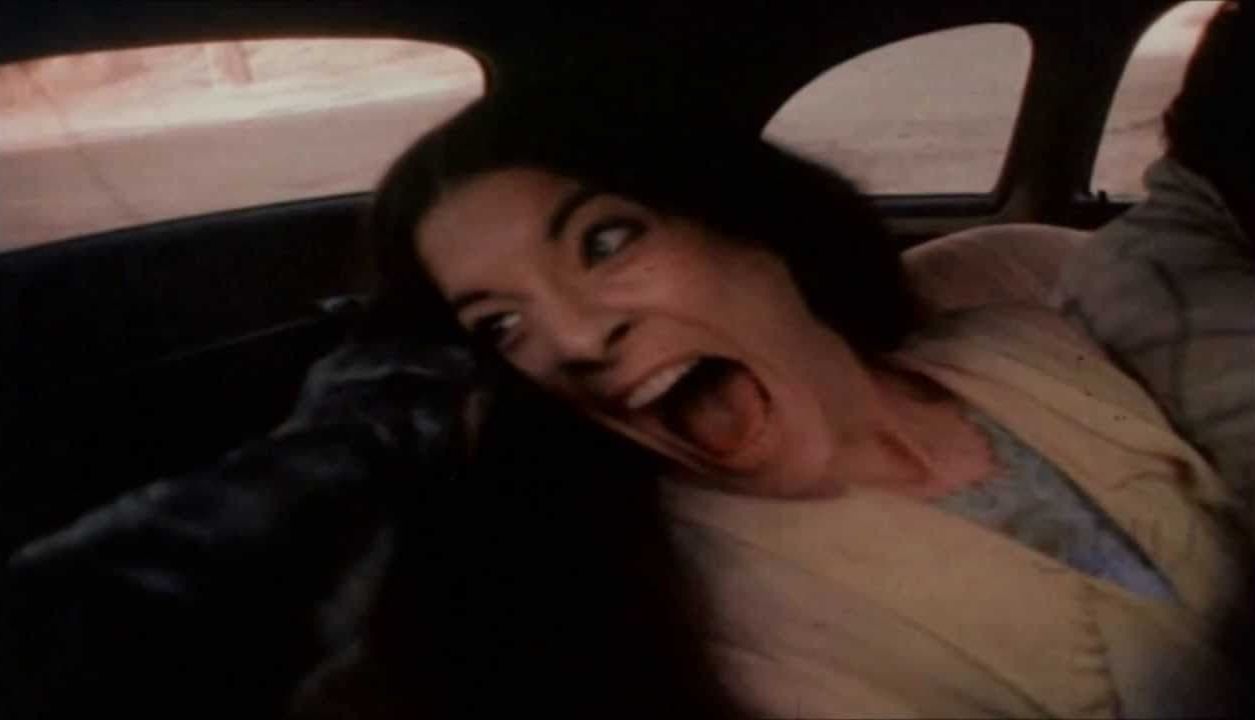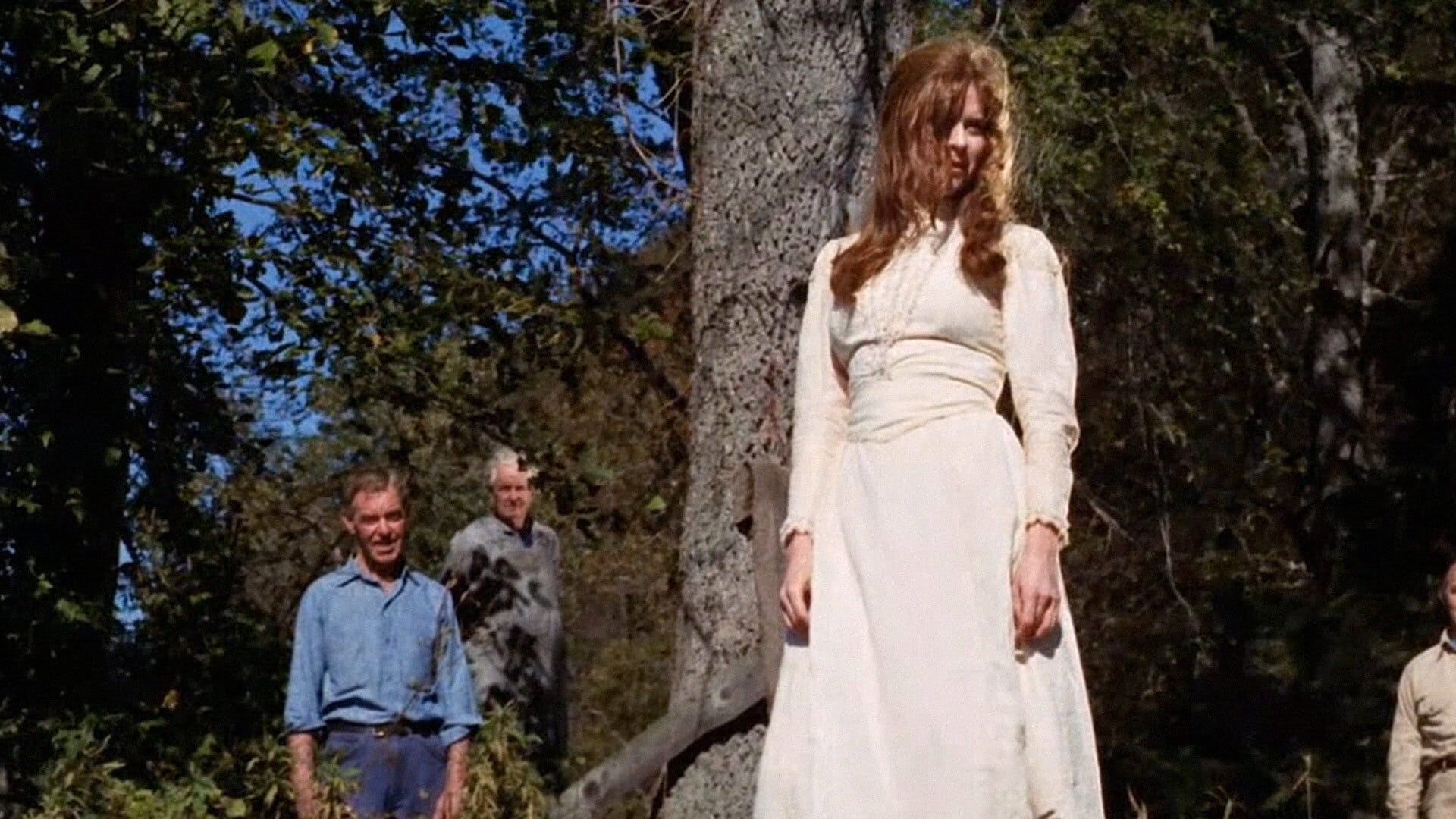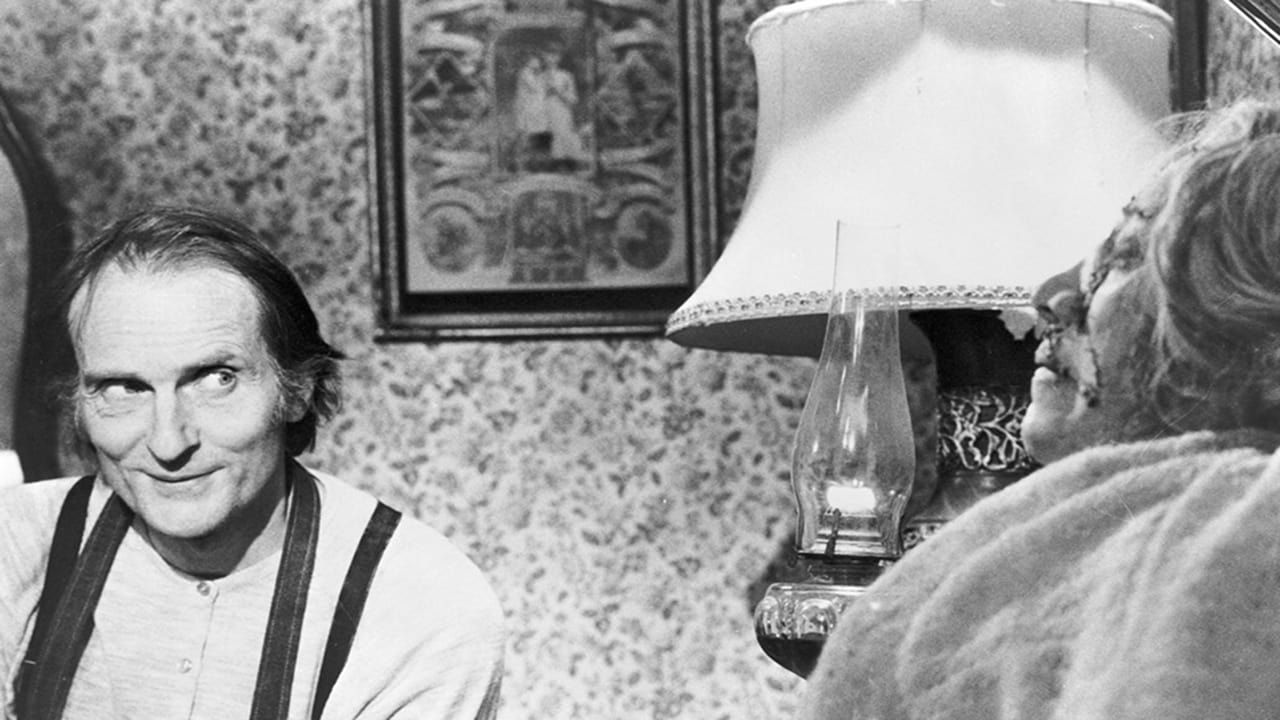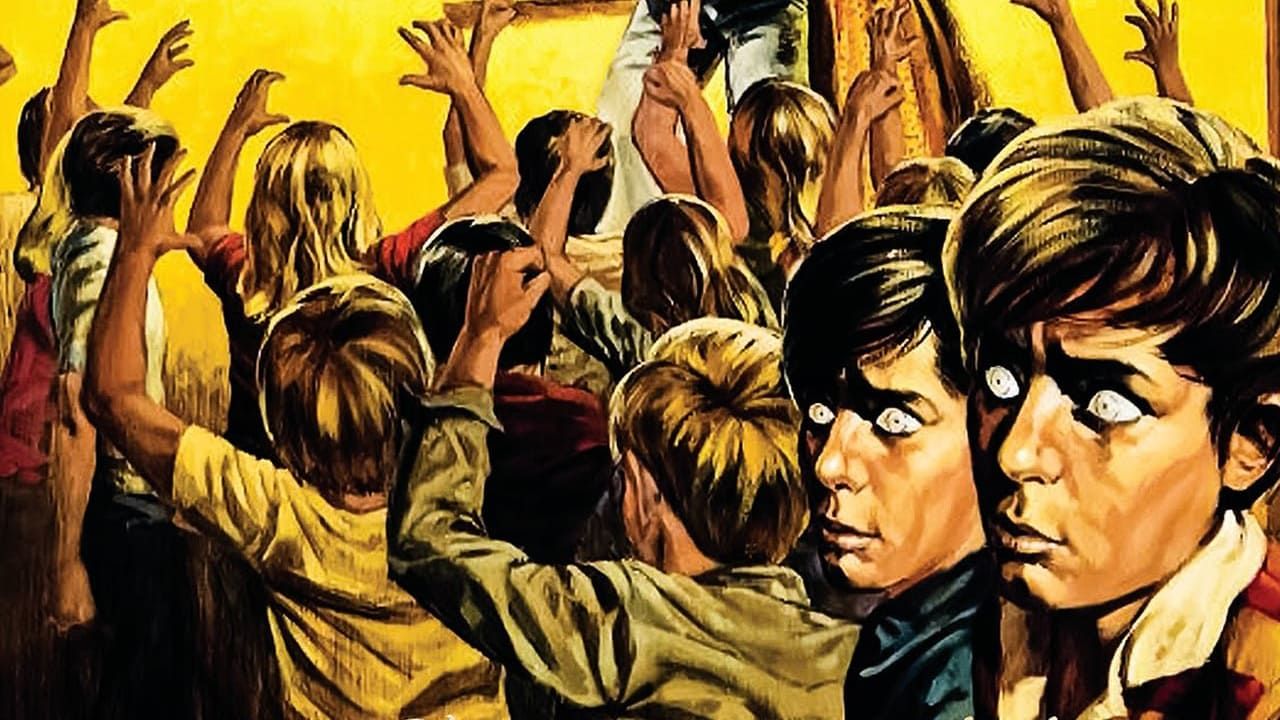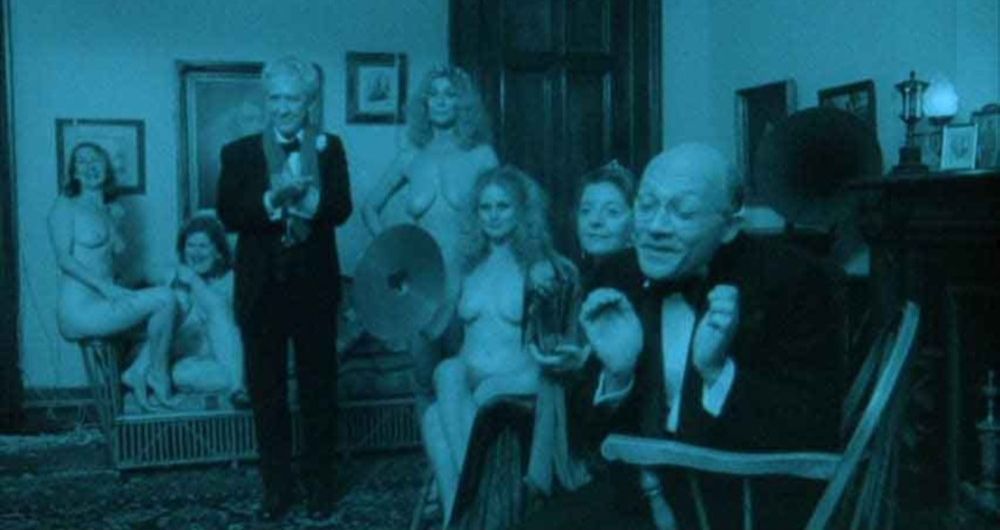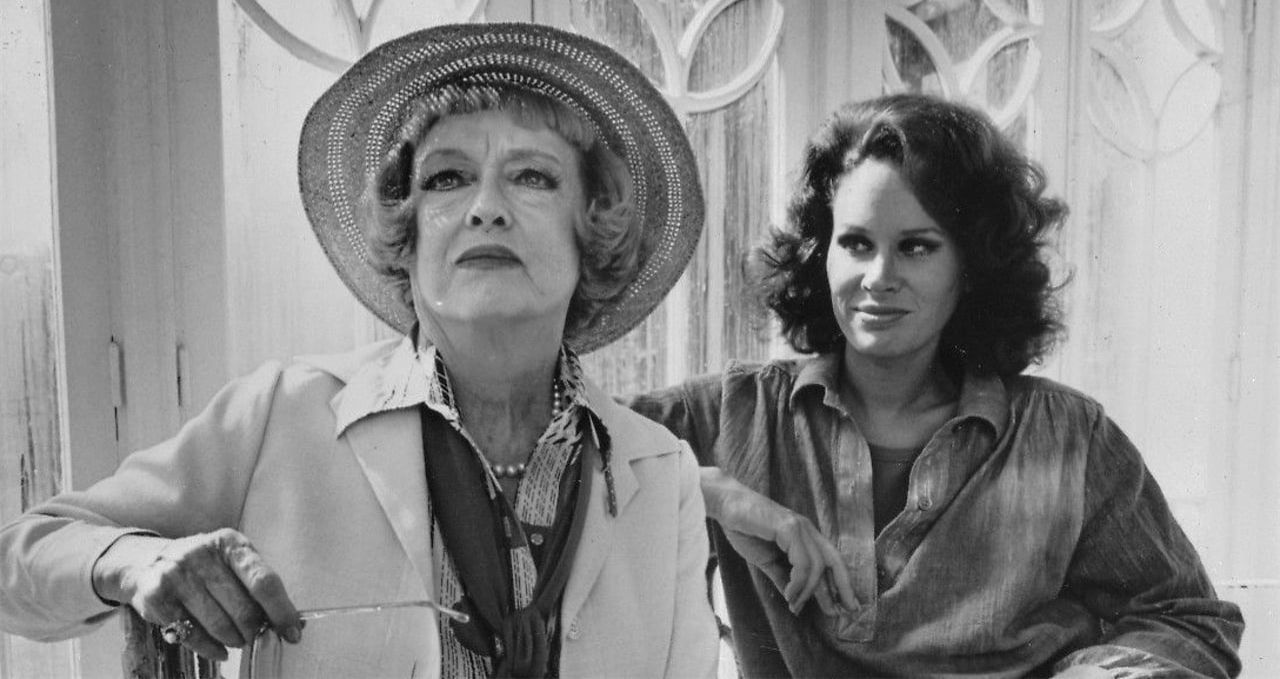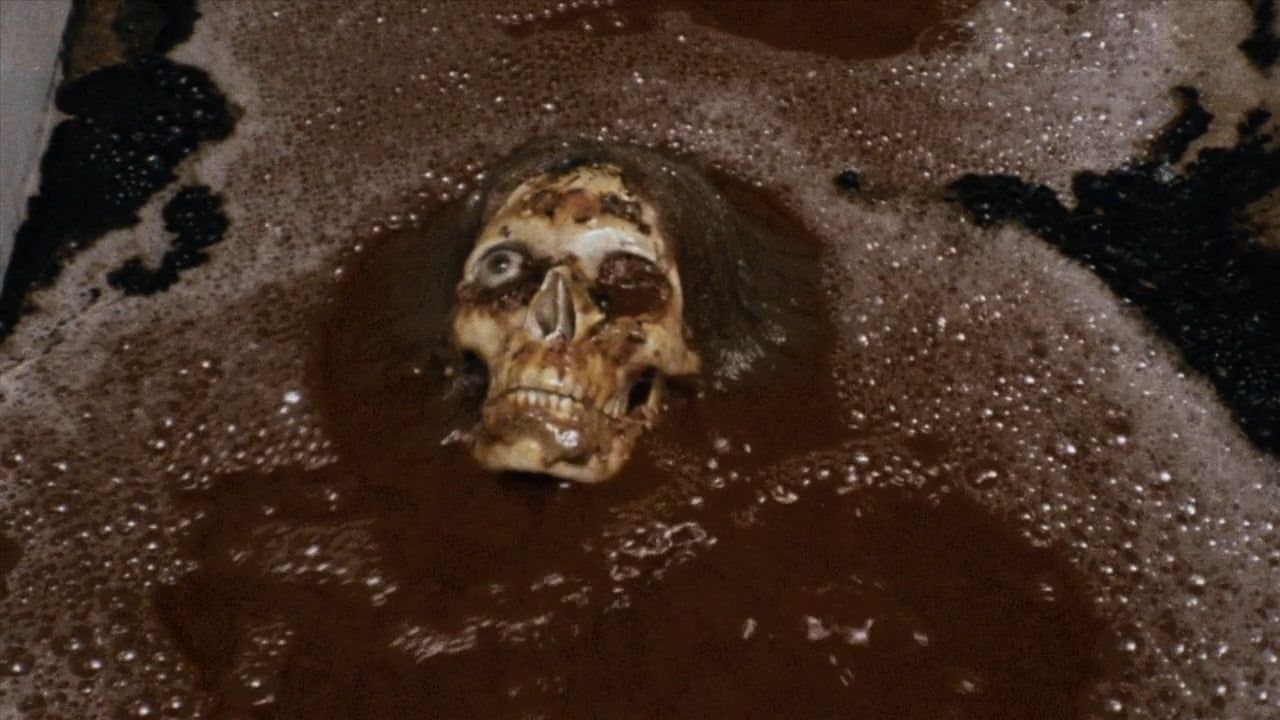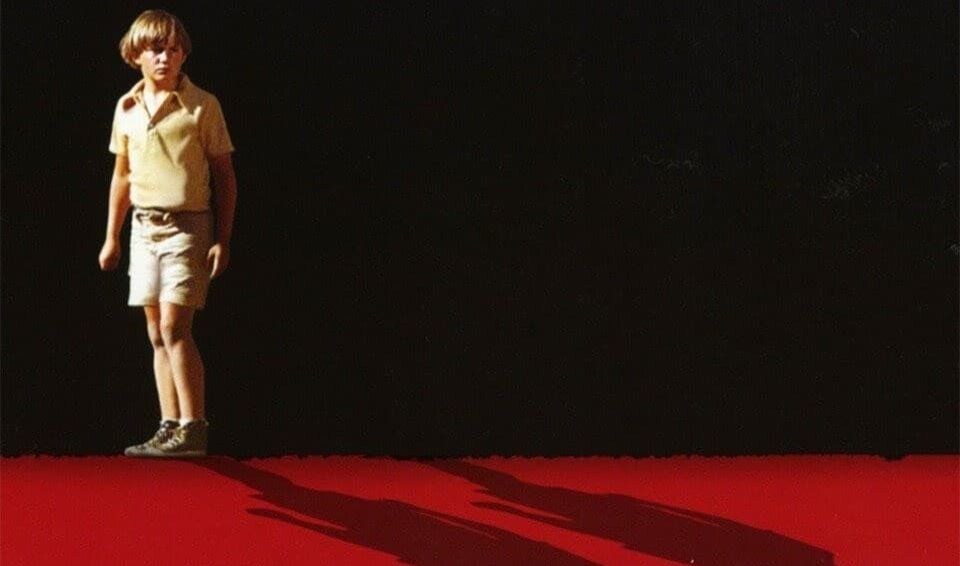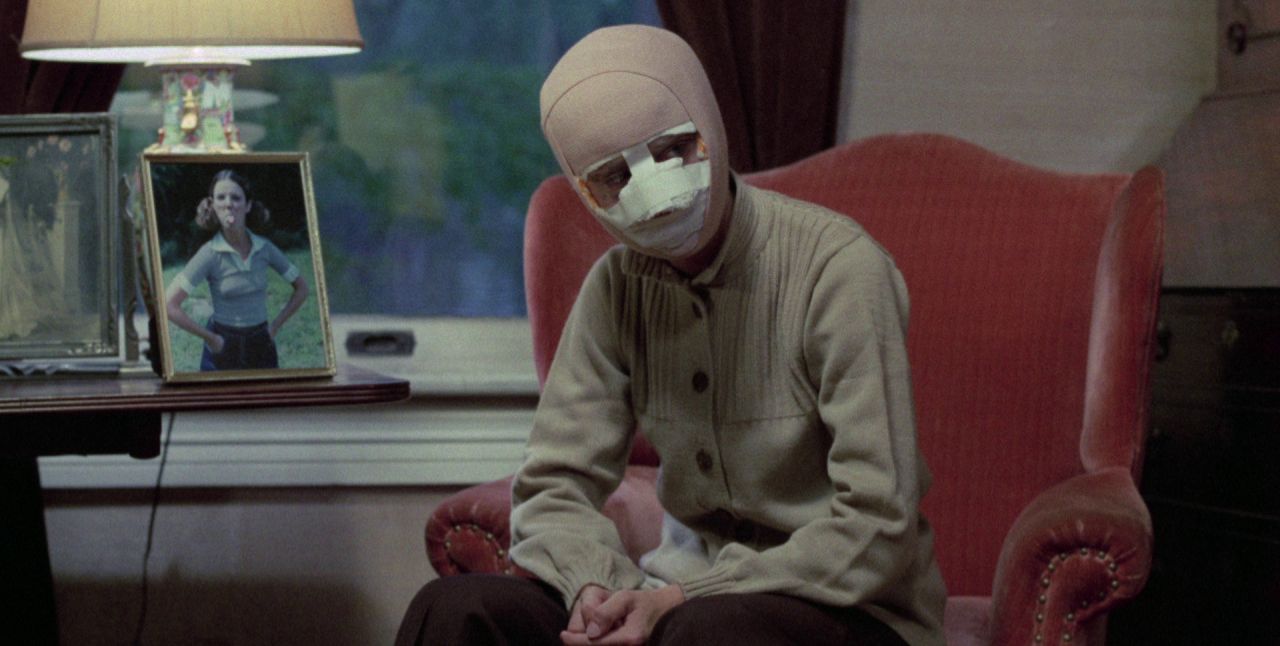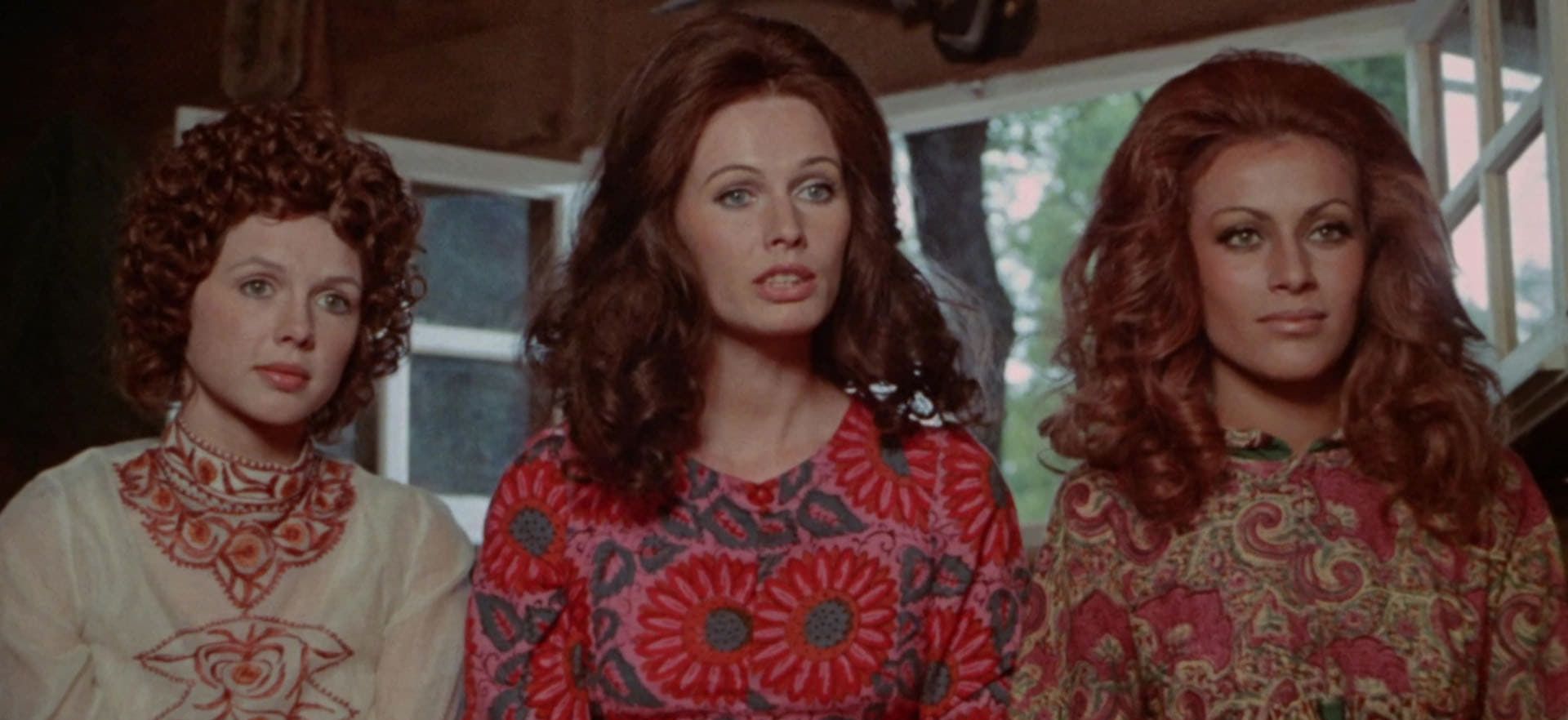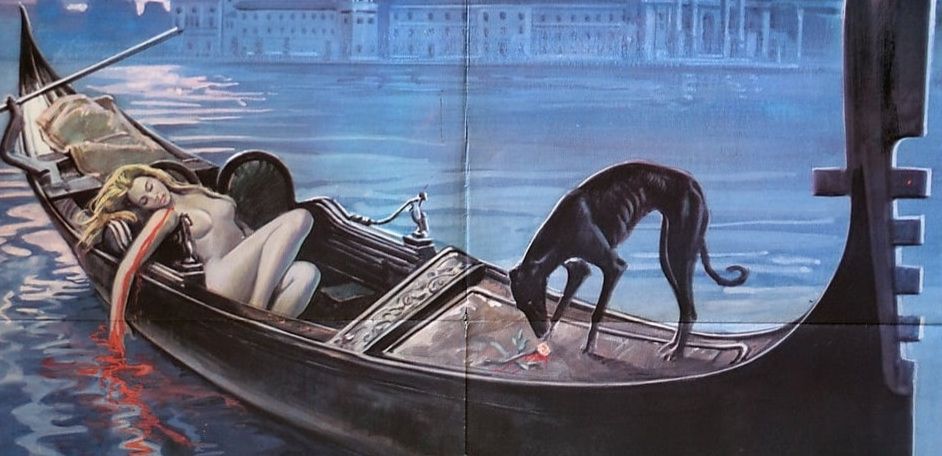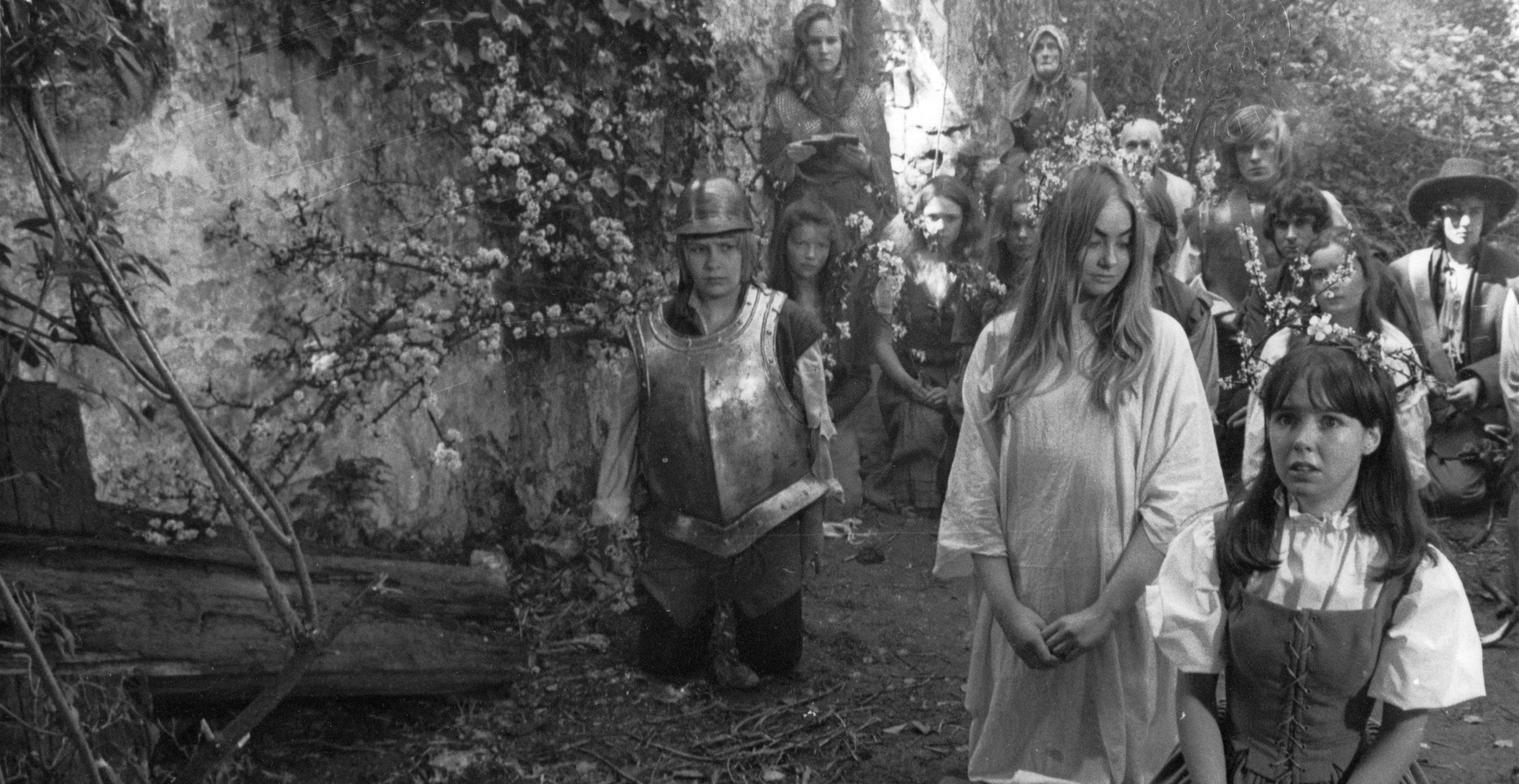Many might call the 1970s the "best decade for horror," and I'm the last person to refute that claim. Some of the greatest, most impactful horror films ever struck their first scares, raised their first hairs, and laid timeless blueprints through the 70s: The Exorcist. Halloween. The Texas Chainsaw Massacre. Carrie. Black Christmas. A "best horrors of the 70s" list largely overlaps with a "Greatest Horror Movies Of All Time list."
It was a far out decade, and evidently ripe for macabre storytelling. General atmosphere was post 60s weird and free, but a tinge darker. Standard religious practices fell under scrutiny, violent crime became more sensationalized in the media, and the presence and influence of cults grew. People were hardening with harshness but opening their minds.
As was inevitable, cinema was getting rawer and more graphic. Filmmakers felt more freedom in depicting blasphemy, sex, and realer-feeling violence. The campy monsters of early horror became human beings. Religious fanaticism came to be a more commonplace point of terror. Depictions of evil were getting close to home. Thus, the 70s spurred a goldmine of artfully inspired horror films dealing with satanic strangeness, spooky folklore, home invasions, and the undead.
We know the familiar titles. Horror hounds know the less familiar 70s horror titles as well. Said horror hounds know, though, that few decades of film have as deep a catalogue of horror gems as the 70s. Atmosphere was vital. Subject matter was far out and freaky. Exploitation edged its way into a wider array of scary flick subgenres. Filmmakers from around the world latched onto the growing love and profitability of horror and contributed great works, original and otherwise. Needless to say, there's a well of underseen atmospheric chillers from the 70s that few outside of horror geek circles seem to praise, and they need highlighting.
This is best kept as all-encompassing as possible, offering seldom seen treasures, but not too obscure as to alienate the novice horror enjoyer. As a horror fan, you may very well know and love some of these films. I hope there's a title or two you weren't previously familiar with. If you're newly digging into the lesser known 70s efforts, I say enjoy! Plenty of witchy weirdness, paranormal terror, and tasteless exploitation to be witnessed.
Messiah Of Evil (1973)
Messiah Of Evil is an artsy and splendidly atmospheric piece of 70s strange surrealness that I will never grow tired of recommending to people. Couple and writing/directing team Willard Huyck and Gloria Katz (American Graffiti) - then fresh out of film school - made this eerie coastal town vampiric nightmare in the stylish vein of Italian and arthouse horror films, and it very much presents that way - dark, odd, gorgeous, with shots like surrealist paintings, and fever dreamlike air made ghastlier by socially disconnected strangers in unidentifiable danger.
Messiah Of Evil is a sort of giallo take on vampire horror that presents like an unhurried, zombie nightmare. It creeps from one peculiar moment to the next, crawling under your skin with uncanny occurrences and haunting imagery that only amps up and grows more visceral as the finale unfolds.
Arletty (Marianna Hill) ventures to a remote seaside town in search of her eccentric artist father who's been missing. She meets a group of young travelers, Thom (Michael Greer) and his lady friends who are also seeking out information on Arletty's dad. Local drunk Charlie (Elisha Cook Jr.) informs the group of strange happenings in this town, warning that a "Blood Moon" is changing people. Arletty discovers disturbing journal entries from her father in his big abandoned home, which detail horrors similar to what the old drunk was ranting about. Soon Arletty and the band of strange travelers experience the vampiric terror themselves.
Everything about Messiah Of Evil is beautifully bizarre, from hollow unusual characters to bits of terror that ooze weird ambiance. The film's colors are like those of a giallo - magenta, purple, and green popping liberally behind haunting set pieces like in Argento's best.
Much of the horror is inspired by a 70s, far-out sensibility, although a few sequences are good old-fashioned haunting as hell. Namely, an unforgettably scary grocery store scene that exudes zombie gold, when a heroine in danger runs into a secluded, eerily lit store, which is empty save for a pack of flesh-hungry soulless night walkers. There's also a spectacular sequence in a movie theater when a cast of lifeless, vampiric film-goers move in for blood on another lone lady. Other bits, like a large albino man cruising around in a pick-up truck full of dead people and eating a rat, leave you uneasy purely in their good old fashioned bizarreness. It's a vampire film that feels like drive-in zombie material, with a surrealist flare and hallucinatory touch.
Messiah Of Evil is damn near perfect as far as low-budget 70s outings go, making the grim gritty best of its coastal setting, sauntering with the energy of a bad acid trip. The film's dated, maybe a little disjointed and perhaps too slow for the modern viewer, but this is a weird and satisfactorily creepy experience for people who like their horror high on aged arty atmosphere.
The Child (1974)
Laying somewhere in the grubby depths beneath the horror cult classics are the flat out obscure titles - lost flicks only known and appreciated by true freaks and genre fans. 1977 evil kid/zombie hybrid The Child is among those hidden weird wonders. An inexpensive seedy old work from director Robert Voskanian, who has no other directorial or writing efforts, this haunt has all the makings of late 70s cult flare - zombies, a heathen child, unexplainable interactions, spectacular landscapes, and gore almost too nasty for its time. The Child holds that devilishly good 70s ambiance, never straying from a feel of unearthly evil, and its gorey moments are a sort of graphic that didn't ooze into mainstream cinema until years later.
The Child opens right up with grim action, as a little blonde girl sits before a grave holding a cat. She hands it off to a decrepit hand that reaches from behind the headstone.
We then follow teen girl Alicianne (Laurel Barnett) on her way to the Nordon house, where she's been hired as the caretaker for young Rosalie Nordon (Rosalie Cole.) The Nordon's house is hidden in a deeply wooded area. En route to the place, Alicianne veers off the road into a ditch. Forced to walk the rest of the way she trudges through the woods and stops when she arrives at the home of jolly old Mrs. Whitfield (Ruth Ballan.) She invites Alicianne in and strikes up conversation, throughout which she shares what little she knows about the Nordons and warns Alicianne multiple times about being safe in the woods.
After departing from Mrs Whitfield's place, Alicianne arrives at the big spooky Nordon house. There's Rosalie (the blonde girl from the opening,) her stone-cold father, and strange older brother. Alicianne learns Rosalie's mother passed away recently, which explains why she spends so much time at a cemetery laying deeper in the forest. Alicianne's mother also passed, which gives her perspective and the desire to truly help this little girl.
Unfortunately for Alicianne and everybody else, Rosalie has strange telekinetic powers she's using for nefarious purposes. New babysitter Alicianne uncovers dark drawings, hints of the supernatural, and eventually the zombies in the woods who may have reanimated with the help of Rosalie. Drive-in zombie fare kicks in.
This flick exceeds realistically low explanations - it's a spooky old hoot. Kicking off with a nice shock in the cemetery, The Child crawls into gorgeously creepy landscapes with old houses in the woods, and a minimal plot churning as the morose atmosphere emanates and a chaotic piano score strikes your blood cold.
Matters grow weird, as they do in virtually any 70s horror film. Rosalie's a manipulative little tyrant radiating pure demonic evil, and that's all good and well, but her father and brother are off, in terms of social skill. Light's flickerin' but nobody's home. I mean the family suffered a serious tragedy with the mother dying and all, but the Nordon fellas are a couple of weirdos. Mrs. Whitfield's a vacant kook herself. Types of supporting characters like these do contribute to atmosphere, but caring about the story becomes a chore for viewers as dull engagements go on.
Stretches veer from the eerie kind of slow, and do feel like a bit of a slog, but The Child pays off with each and every zombie appearance. The flesh munching's obtuse and well-done for the budget and time. It isn't overdone shlock but Voskanian cranks up the volume to "pretty dang gorey." This guy exhibited a taste for zombies gouging eyeballs before Fulci. Surprisingly ambitious nastiness going on in what otherwise comes off as a wayside supernatural horror of the 70s. That packaged deal of demonic child, supernatural sizzle, and splattery zombie romp is hard to come by.
Don't let obscurity off-put, this is top-notch old-school zombie fare and then some. It's 70s "out there" but that's what so many of us are in it for. The Child is a little bit The Omen, a small part Carrie, a tad Night Of The Living Dead, and I would believe heavily influenced by earlier zombie Euro flicks like Tombs Of The Blind Dead and Let Sleeping Corpses Lie. I reckon this is a movie best fit for late-night viewing alone off a very high THC wax pen, or with a weird person who also appreciates this stuff like you.
Let's Scare Jessica To Death (1971)
Many older horror heads and those who dig for underappreciated classics have long known or already come to love the ghastly paranoia of Let's Scare Jessica To Death, but this illusory, hippy dippy slow-burn still needs more attention.
Zohra Lampert plays Jessica, who was recently released from a mental institution. She goes to an isolated farmhouse to live comfortably with her husband and his free-spirited, beatnik friends. Bizarre, paranormal events start occurring, and it's impossible for Jessica and those around her to discern whether they're supernatural or a result of her psychosis.
Let's Scare Jessica To Death is an eerie product of its time and all the uncannier for it. New agey characters make for something late 60s and "far out." No person or thing seems connected to reality, as we descend into ethereal paranoia along with Jessica.
The setting includes great atmospheric horror hotspots, from a secluded farmhouse, sprawling woods, a big body of water, and an old timey in the sticks town where unwelcoming locals walk without soul. The score is kept minimal, sometimes limited specifically to haunting tones and the voices in Jessica's head. The sound production with disorienting camerawork
Let's Scare Jessica To Death is a dated film that benefits from age and a low-budget. Its creepish unfolding of events blends naturally with the slow, artistic camera work, as psychological terror builds with subtlety. We, the audience, are forced to genuinely wonder whether this nightmare is paranormal or purely psychological. As the "scares" creep in, they spook on top of the already unsettling and unshakeable feeling that starts from the film's beginning and never ceases. You'll read the word "atmospheric" several times throughout this piece, or really in any piece of writing on old horror films. I don't say half-heartedly that Let's Scare Jessica To Death is possibly the most atmospheric of the atmospheric gems. Drenched in paranoia and unearthly, indescribable horror. Scored mostly the whispers in Jessica's mind. It's a skin-crawling good time,and the "lady in gown emerging from a lake" scene is still one of my favorite horror moments ever.
Deranged: Confessions Of A Necrophile (1974)
Of the many films based on serial killer Ed Gein, Deranged isn't one of the most renowned, but it's a crafty and unique creepfest that utilizes a partial-mockumentary style, helping matters rise to chilling levels. Brilliant character actor Roberts Blossom depicts Gein in an almost sympathetic way, leaving you unsure whether to feel bad or be repulsed, at least early in the film, before he starts committing one hellish act after another.
We follow Ezra Cobb, a sad old lonely farmer in rural Wisconsin who lives with and cares for his bedridden, overbearing mother (Cosette Lee.) Following her death, Ezra's left alone, lost, and free. He snaps, robs her grave, and exhibits an increasing fascination with corpses.
Deranged is nightmarishly trippy and extra unsettling due to the showing from Blossoms as a convincingly disturbed yet tortured and practically pitiful lead character. You do sort of feel for Ezra, with his isolated rural life and nut mother. Early on there's a real sadness as Ezra is depicted as a victim of his mother's longstanding emotional abuse. An eeriness crawls up from beneath the melancholy, pervading, but you're still left almost empathizing even as Ezra devolves into a sickening maniac. When Ezra's disturbing behaviors start - i.e. communicating with dead bodies, stalking innocent women at dive bars, etc. - the mood quickly grows uneasy. It's all-out disturbing imagery and dark character drama from then on out.
The directing team of Jeff Gillen and Alan Ormsby favors a loony psychological haunt and dark ass creepy crawl over crude slash'em up antics, but the spooky happenings are eerie material, I promise ya. Deranged has gore, sickening sights, and uneasy violence. Curiously good performances given the sheer level of sleaze going on. A slight tinge of humor to it as the story's told partly through documentary-style newscasting. There are visuals you won't soon forget, and a mood you won't easily shake. The flick does get gross in nature and come off as slightly outrageous during a few attempted scares, but it's a movie about a necrophiliac from 1974.
Who Can Kill A Child? (1976)
Spanish horror has hits, ranging from respected classics to the many old cult efforts that are being dug out of obscurity. One of Spain's most haunting forgotten highlights is Narcisco Ibanez Serrador's evil moody number Who Can Kill A Child?- a hair-raising killer kid chiller set on a colorful but not so lively island. In the area of cult-like murderous children taking over isolated places, Who Can Kill A Child? predates Children Of The Corn, and features similar ideas and playout.
English tourists Tom (Lewis Fiander) and Evelyn (Prunella Ransome) take a rented boat to the fictitious island of Almanzora off the southern Spanish coast. They soon realize the island is absent of any adults. The residents are all creepy children who don't speak, instead opting to stare with evil smiles on their faces. Tom and Evelyn figure a mysterious, dark force must be overtaking the children, forcing them to kill their elders.
Who Can Kill A Child? Is as foul and bleak as the name might suggest. The whole thing feels hopeless from start to finish. Tom and Evelyn are pit against the ultimate evil, a group of murderous children who are hard to defend against simply because they're children. Though action might seem tame by today's standards, there's savage kills and cinematic limits being pushed.
On a more thought-provoking level, Ibanez poses us with interesting questions as this grim story unfolds. Questions like: "Could you kill a child?" "Could you kill a fetus if you believed it to be contaminated by evil in the atmosphere?"
Questions I ask myself pretty much everyday.
This is Village Of The Damned but not so sci-fi; more exploitation and less camp. A cut-and-dry chilly killer kid horror with shocking violence in a deliciously isolated setting.
The Sentinel (1977)
The Sentinel appears frequently in lists I compile. Perhaps because it's one of my favorite weird horrors ever. I don't know if this film's "underrated" or super unknown. Surely to younger generations. It wasn't released quietly in the late 70s, the cast is loaded with stars, and I imagine it received airtime on cable networks back in the day, but director Michael Winner's satanic, psychedelic haunt The Sentinel fell out of discussion long ago. When we talk about truly unsettling movies, I feel this peculiarly spooky old, evil-feeling 70s romp needs mention.
A young model Alison Parker (Cristina Raines) is living with her lawyer friend; potential boyfriend Michael (Chris Sarandon) in his apartment. Alison has undergone changes after mental health struggles and suicide attempts. She strayed from the Catholic church, and is newly expressing interest in finding a place of her own. With the help of a realtor, she finds a place in a gorgeous old building in Brooklyn Heights.
In the top window of the building sits an old ghastly looking man, who the realtor says is a blind priest. After moving in, Alison meets her neighbor, a strange old gentleman who throws a birthday party for his cat. He introduces Alison to other neighbors in the building, who are all a special definition of weird. There's an emotionless lesbian ballerina couple, one of whom played by Beverly D'Angelo doesn't speak - only pleasures herself in front of Alison.
Gradually, activity in the apartment comes off as more aggressively odd. Alison loses grip of reality, or perhaps it's reality around her that's uncanny and crumbling. She learns her building may be a gateway to Hell.
The Sentinel has what seems to be an acid-laced vision and transgression, servicing that unmatched 70s depraved, weird air. Though it's clearly inspired by Rosemary's Baby, and made in the latter part of a decade dominated by satanic subject matter, The Sentinel has original ideas, frightening sights and its own special dash of far out freaky. Lead Alison suffers flashbacks to disturbing sexual escapades of her father's, while she's currently living in a slowly unraveling hell full of oddballs. The mood's always nightmarish. The look is 70s New York, raw but dreamy, edgy but posh. A sense of evil crawls through the pure uncanny moments, and the imagery meant to scare - a zombified abusive father, a satanic priest, and an army of deformed people - do their unnerving job.
Winner received flak for some of the scares served in The Sentinel, as he used real people with deformities to play the demonic creatures who appear as the gate to hell is open. Today that sounds tasteless. It was in poor taste then, too. But it's authentic. Unsettling. Effectively scary. Call me a bad guy (please don't,) but The Sentinel's climax is a real haunt, and I feel Winner's questionable choice created great horror.
Several memorable scares to be seen, that climax included, and the performances strike a nerve also.
The star-studded cast helps a generic but decent, simple plot rise to terrifically spooky heights. Burgess Meredith brings something equally endearing and worrisome to a friendly but creepy old neighbor. Sylvia Miles is the forceful and cold of the oddball ballerina couple, speaking in a heavy slavic accent and posing a rather icy presence. The roster of stars supporting stars is insane. John Carradine, Ava Gardner, Mel Ferrer, Arthur Kennedy, and a young Christopher Walken. Tom Berenger sneaks his way into the end, there. Hell of an impressive lineup for an old horror few seem to give a shit about.
Just like with any flick on this list, The Sentinel might be too "slow," or "odd" for someone accustomed to now, but this ghoulish number will get under your skin if you're in the right mood and can just settle into the fevery feel. An unsavory supernatural sizzler, wrongfully left in the 70s. One of my main goals in life, among so few, is helping this film find its proper audience.
Burnt Offerings (1976)
Another movie that comes up frequently in my list writing, Burnt Offerings is an unusual haunted house horror; among what I'd call quintessential haunted house fare, that's splendidly dark, well-acted, and still effectively chilling despite hokiness.
Oliver Reed and Karen Black star as a couple (The Rolfs) with a young son who rent a mansion for the summer. An unseen force in the home holds power over the Rolfs, which has profound psychological effects. Reed's character Ben becomes violent while Karen Black, playing Marian, grows weirdly obsessed with and attached to the home. Ben starts having haunting flashbacks to a funeral he attended in his childhood. Those eerie black and white flashbacks, featuring a nameless, tall, grinning chauffeur, are to me some of the scariest moments in horror movie history.
The film overall has a real precarious ambiance and creeping mania to it. It's reminiscent of The Shining, though it came before, and Stephen King himself has claimed Burnt Offerings and the novel it was based on were inspiration for his story. Director Dan Curtis hikes up atmospherics, shooting lots of low shots that make the old rural mansion look gargantuan and haunting. The home's interior is like what you'd see if you were told to close your eyes and picture an old haunted house. Its property is too quaint to not become a living hell. The not cared for, greenish pool provides a fine setting for Ben to devolve into a violent maniac in one gripping scene.
Atmosphere and acting do heavy lifting. Oliver Reed and Karen Black need no praise - but I will note, Reed plays an intimidating patriarch who's scary to watch descend into madness. The supporting cast, including horror all-star team captain Burgess Meredith, bring spooky performances. Burnt Offerings is a compelling, psychologically-driven haunting flick that's good, but the aforementioned chauffeur is who makes this great horror.
Beyond The Darkness (1979)
Italian arthouse sleaze artist Joe D'amato started in adult films, and all of his genre work that followed in the 70s and 80s was no more savory. Among prolific Italian horror directors, he's no Bava, Argento, or Fulci in terms of making lasting classics, but D'amato is in that cut just underneath, with the less sung shlock masters and horror minds who made cult favorites. Guys like Umberto Lenzi, Ruggero Deodato, and exploitation auteurs. D'amato made several films that come up in horror conversation and evidently have their fan bases. His biggest fan favorite, Anthropohagus, is a rather slow cannibalism flick set on a Greek Isle, and the film carries a reputation for being gruesome. It's artfully done and a pleasantly creepy late 70s product, but it's boring and underwhelming for my taste. His slasher Absurd is a gorey, bizarre treat, also on the slower side. My favorite of the disgusting, sleazy 70s Joe D'amato horrors is Beyond The Darkness, a light tale of taxidermy and necrophilia.
Beyond The Darkness is everything a D'amato film is - On the drug-induced, art student side in terms of execution. Slow-moving and always strange and uncomfortable. A gorey violent mess for its weird characters. Generally, it's a disturbing old chiller that's spacy, loaded with nudity, and distasteful beyond belief.
A young man Francesco (Kieran Canter,) who was orphaned as a child, lives with his overprotective caretaker Iris (Franca Stoppi) in a secluded house in the woods. In a rage of jealousy against Francesco's girlfriend Anna, Iris kills her with a voodoo doll. Not content to go on without her, Francesco brings Anna back through taxidermy.
As with all Joe D'amato films, Beyond The Darkness feels filthy to watch. A depraved tale with a gorey, gruesome, audacious execution. Exploitative as it be, however, it's slow to the point of almost dull, and consistently unnerving. D'amato takes his sluggish time and dedicates attention to intimate shots. Violence is filmed with gentleness like a 70s porno. It feels gross and wrong. I love this film. Acting is questionable and there isn't a character to give a damn about, but this is heady exploitative discomfort.
The Other (1972)
Directed by Robert Mulligan and based on the Thomas Tryon novel of the same name, this spooky, slow-churning, old school tale of rural farm town terror has rightfully established a cult fan base of atmospheric horror heads. It poses as an escape into slow and sprawling 1930s rural America, but an underlying evil lingers in this quaint farm town. The air is stale and the mood is uncertain. Matters start feeling supernatural, but the horror proves to be even more shocking, and even more human.
Set in a 1930s peaceful Connecticut farm town, The Other follows 12-year old twins Niles (Chris Udvarnoky) and Perry (Martin Udvarnoky) Holland, who live with their grandmother Ada (Uta Hagen.) Ada teaches the boys something called "the game," but as they play it unfortunate occurrences begin happening. This nowhere farm town sees violence like it never has. Left confused and saddened, Ada pieces together that Perry may have something to do with negative events taking place.
The Other is a classic exercise in atmospheric dread, moving slowly in a quiet pretty place towards a big twist, which sounds like most any film on this list, but Mulligan reveals the "shock" to us fairly early and has more twists in store. His approach is that of a classic horror director, carefully framing, leaving beautiful shots looming, creating the feel of an old supernatural haunt. What unfolds is on the psychological end of terrifying. It's grim and surprising. Turns are particularly dark for something early 70s. The Other pairs old school tactics with newer school, shocking subject matter, creating a lasting and unique kind of moody early 70s horror. Chris and Martin Udvarnoky serve creepy performances as the difficult to gauge, weird little twins, and Uta Hagen puts on a powerful acting display as unlikely hero Ada.
Scalpel (1977)
It isn't frequently you hear mention of late 70s oddity Scalpel, but I believe Giallo and gothic horror fans would love this disturbing melodramatic psycho thriller for its southern gothic essence and twisty, steamy, deranged playout.
Dr. Phillip Reynolds (Robert Lansing) is a psychotic plastic surgeon who learns his missing daughter (who left due to the doc's wildly violent tendencies) is inheriting the family fortune, which infuriates him. One evening he finds a beaten down go-go dancer named Heather (Judith Chapman.) He offers to reconstruct her face and promises her a piece of the money his daughter's inheriting, but he's going to remodel her face in the likeness of his daughter.
Scalpel is more a super unsettling mix of sleazy soap opera and psychological thriller than it is a straightforward horror film, but it's shocking and deranged and all that you'd hope to see in your ambient 70s efforts.
Robert Lansing is a wonderfully infuriating leading madman - kind in appearance, posing as trustworthy, but a monster within. An exciting character to be unsettled by as he cons, abuses, and demonstrates incestual affections. Judith Chapman, serving in 2 roles, is truly compelling as a victim of Doc Reynolds' madness. She cuts through the weird ambiance and delivers an oddly engaging performance, causing matters to feel heavier as they darken.
Once Heather's reconstructed to look like Doc's daughter we get into uncomfortable territory. Scalpel takes nasty turns and doesn't skimp on suggestive imagery. Director John Grissmer only made one other film, 1987 arguable cult classic Blood Rage. He has a handle on soapy psycho drama here, and though Scalpel has the dry framing and look of a television movie, that weird air serves the film well. It's dry, dramatic, and character-driven. Its ideas are disturbing, and the execution is truly disconcerting in such an airy vessel. Scalpel is a seedy and haunting bleak old number, and Grissmer should have made more films.
Queens Of Evil (1970)
While it may play as a painfully slow burn, Queens Of Evil is offbeat early Eurotrash with a fun frightening payoff. Tonino Cervi's little-known Italian shocker doesn't fit easily into a subgenre - it's sleazy sexploitation, it's folk horror; generally it's one of those slow, bizarre, not completely coherent old horrors you watch to get lost in disconcerting strangeness.
A hippie traveling by motorcycle (Ray Lovelock) happens upon an isolated house in the woods that he believes to be abandoned. After spending the night in the shed, he's awoken to realize 3 sisters (Evelyn Stewart, Sylvia Monti, Haydee Politof) live in the home. A decadent placeThey invite motorcyclist David to stay, leading to lovin', intimate moments, and a witchy twist.
Artful, polished, not particularly eventful, but captivating in its arid walk towards terror, Queens Of Evil is what I'd call a unique piece of dark arts erotica. Cervi's twist ending is pretty expected, while still being ghastly fun. It will no doubt please genre weirdos, but this far out sleazy crabwalk isn't for everybody. It's an Italian genre film, from the beginning of the 70s, dealing in sex and the macabre, which means there's one major selling point: Peculiar atmosphere.
Stewart, Monti, and Politof share an alluring, mysterious chemistry as the leading ladies and contribute to a foreboding aura. The flick's tantalizing in a shameful to admit way. An out of place remote wooden setting. A home with a stylish decadent interior sitting alone, where a group of random ladies live? And these ladies are just giving a hippie stranger the romantic time of his life? Doesn't take a seasoned horror watcher to sense skin-crawling strangeness afoot, yet you're also made a sort of curious that extends beyond dark horror suspicions. I'm suggesting you might be a little turned on if you're a weirdo, and that's who Queens Of Evil is for. Like most everything here on this list, the film is a far out, sexually drenched, drug-laced kind of odd
Damned In Venice (1978)
Giallo in visual but occult horror in premise, Damned In Venice is obscure old Italian fare that has the expected faults, like dull stretches and bad editing, but this is a grim chiller in the "birthing the antichrist" field, set in a picturesque Venice of a different time, that's a valuable eerie entry in the log of underappreciated Italian horror.
Following the death of their religious zealot grandmother, a blind boy Mark (Renato Cestie) and his narcissistic brat sister Christine (Rena Niehaus) head to Venice to live with their sickly aunt and depressed uncle. When their aunt dies, the uncle kills himself soon after, leaving Christine to care for Mark. She turns the Venice residence into a brothel, as Mark begins having disturbing visions about a demonic presence in his sister and Hell to come. Christine, despite being a virgin, becomes pregnant. Her treatment of Mark goes from bad to sadistic evil. Young Mark is left to fend off the devil.
Rosemary's Baby influenced a litter of "pregnant with the devil" films across the world, and not long after, The Exorcist spurred a cavalcade of possession flicks. You could spend a lot of time seeking out European rip-offs of these satanic classics. You might find many inventive films that were inspired by those, but have original stuff going for them. Legitimately scary, decent low-budget Italian efforts run deeper than you'd think. Damned In Venice is a hard to find entry in the Italian Rosemary's Baby& The Exorcist-like copy bin, but it's an original one well worth looking for.
The relationship between Mark, who's blind and mostly helpless, and his terribly unlikable mean sister Christine is uncomfortable. Sad drama piles on. There's a crushing, weird sadness weaved throughout, but as Mark starts having gross visions of apocalyptic doom, we have pure horror on top of an extremely sad story. Director Ugo Liberatore puts the pair of youngsters in the unreal-looking city of Venice, which should be spared of the sleaze and evil taking place. Beautiful scenery can't stop the brothel action, visions of satan, insects and rodents making many unwanted appearances, people being pierced with nails, appearance of the devil, and baby murder.
Damned In Venice is rather violent and grim without getting over the top, as say an "Exorcist rip-off" would. The performers all take themselves seriously and act well, making this feel more menacing than something low-budget and not completely coherent should. It's distasteful and loaded with nudity but not exploitative. It's brutal but not in gorey fashion. You'll see a corpse decompose, but it won't be over-the-top and goofy, if you know what I'm saying. Ugo Liberatore's seemingly unknown knocked up by the antichrist romp is pretty pure old Italian horror, with added wretchedness.
The Blood On Satan's Claw (1971)
The Blood On Satan's Claw is a richly atmospheric, devilishly spooky British folk horror classic, and as Hammer feeling as a non-Hammer film can feel. A moody slow-churner of occult terror that has the essentials: Cult rituals. Murderous kids. Witch paranoia. It's all going down across a gorgeous pastoral landscape and dripping with fiendish feel.
Witch hysteria's running through a small village in the English countryside. Dead bodies are turning up, with patches of fur on them. Young, seemingly popular girl Angel (Linda Hayden) joins a local judge and ploughman in their detective work and mission to figure out and fight whatever witchy evil is overtaking the village. Little do the adults know, Angela is in on the Pagan practices responsible, along with every other youngster in town.
As far as folk horror goes, The Blood On Satan's is a quintessential minor classic of the subgenre that has the moodiness, scenic setting, and evil imagery that has become standard. It's a pretty, hazy daytime crawl, as crazily religious residents of this 17th century village fight amongst each other and startling deaths are discovered. Spooky pagan practices are peppered throughout, before an eventful final act when cult horrors become evident. What unfolds is a worthy, shocking payoff that's disturbing for its time. The climax is both more sexual and shocking in nature than one would expect from such seemingly traditional horror.
Linda Hayden is a young, compelling scary villain, and pertinent to the film's horrific turns being genuinely unsettling rather than corny and dated. She manipulates the village's adults through a doomy descent into occult terror, and does so in a heartless grim way that lends to an already oozing dark ambiance. The Blood On Satan's Claw isn't a film I'm just talking up for the sake of a list, it's a fantastic, atmospheric British horror classic.

